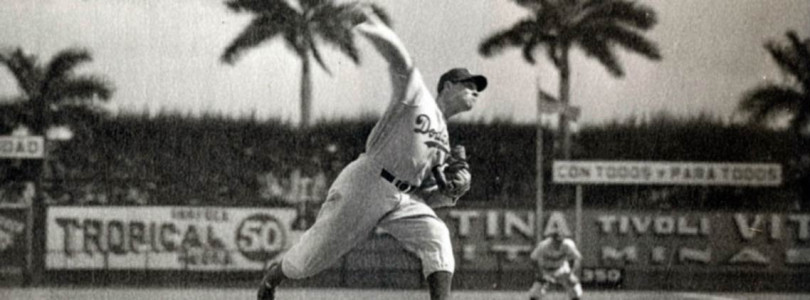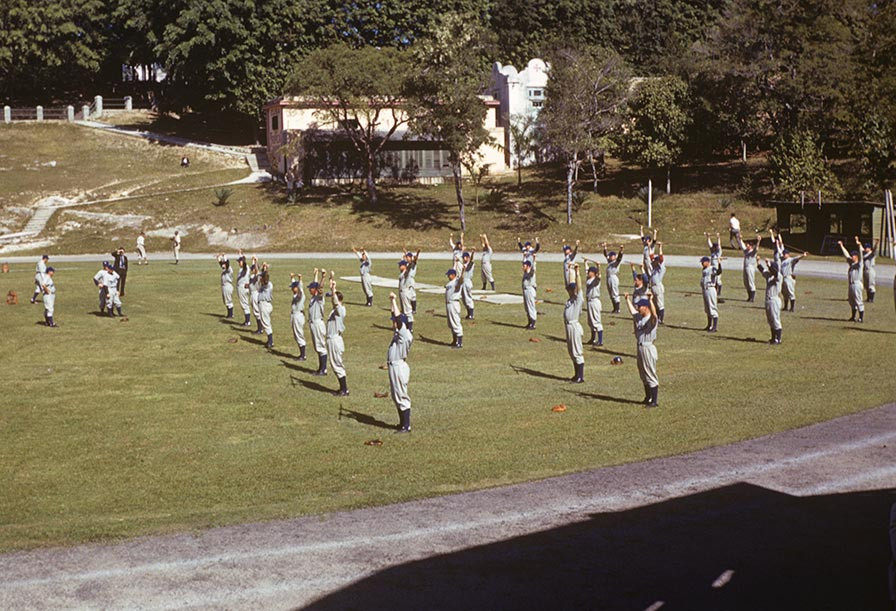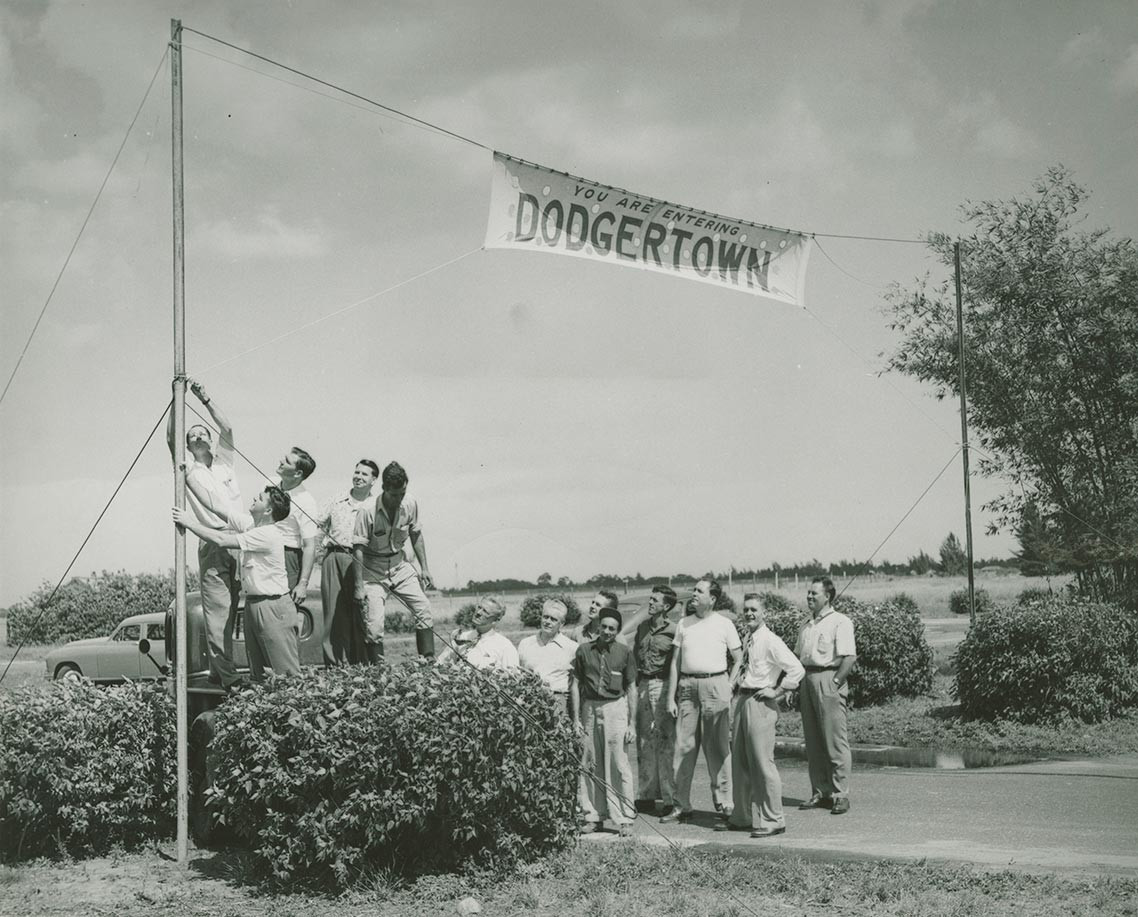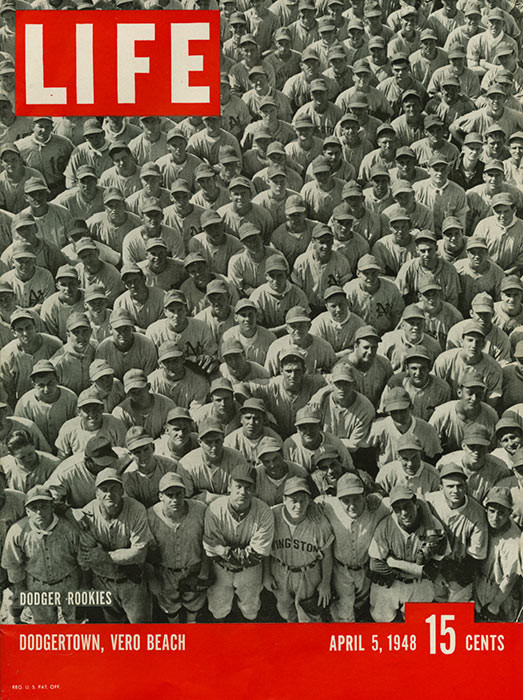
Dodgertown Historic Timeline
1940s
-
According to author George W. Gross, the U.S. Naval Air Station, Vero Beach, Florida was commissioned on November 24, 1942 “to provide a Navy and Marine flight training base for over 2,700 men and 300 WAVES and women Marines. The purpose of the NAS was constantly revised from originally training dive bomber pilots to daytime pilots and ultimately to nighttime fighter pilots. Although extensive safety procedures were established, records show 105 lives were lost in flight training accidents.” George W. Gross, P.E., “U.S. Naval Air Station at Vero Beach, Florida During World War II”, back cover, 2002
-
On May 10, the City of Vero Beach receives the land and training facility back from the U.S. Government under the terms “that any use of the facilities was subject to federal approval and any funds acquired from use or sale of the airbase property must be retained in a special fund and applied exclusively to the maintenance or development of flight facilities.” By June 1946, all training ceased, transfer of nearly all personnel began, and the base prepared to assume caretaker status, with a minimum crew of 30 civilian workers and 25 Navy men.” George W. Gross, P.E., “U.S. Naval Air Station at Vero Beach, Florida During World War II,” 2002, Chapter 7, Pg. 119
-
In February, the Dodgers set up their training camp in Havana, Cuba, a long way from Brooklyn, but team president Branch Rickey strategically wanted to keep his “great experiment” of breaking baseball’s color barrier with Jackie Robinson under wraps as long and as quietly as possible. Racial discrimination was less prevalent in Havana, where African-American players had regularly participated in the Cuban Winter Leagues. Although Robinson would not be housed at the team’s headquarters, the plush Hotel Nacional, he would have relative insulation and a safe haven at the Hotel Boston in old Havana.
On July 18, regarding a base for 1948 Spring Training, Rickey reports to the Board of Directors, “that he was in receipt of a firm offer from the Dominican Republic, which has invited the Brooklyn organization to train there.”
Rickey had told his family and some close friends that the club was searching for a training site in the United States. Rickey’s daughter mentioned the fact to a neighbor, Dick Cameron, who in turn relayed the information to Bud Holman. John L. Klucina, Vero Beach Press-Journal, February 22, 1968
Holman approaches the Brooklyn Dodgers about the possibility of using land at the former U.S. Naval Air Station, now owned by the City of Vero Beach, for Spring Training activities. In response, Dodger President Rickey, who was looking for a U.S. site to train the Dodgers and their 26 minor league teams in a self-contained camp setting, dispatches Buzzie Bavasi, General Manager of the minor league Nashua, NH team, by train on November 2, to evaluate the facilities.
Bavasi recalls he was supposed to head south after seeing the Vero Beach facilities to evaluate other possible training sites in Ft. Pierce or Stuart, but was impressed with Vero. “To make a long story short, I never made it to Fort Pierce or Stuart,” recalled Bavasi. Dodger Edition, Vero Beach Press Journal, March 1, 2002 “Bud Holman met me at the train and he wouldn’t let me go any farther south. The facilities were already there. All we had to do was put in the ball fields. Another thing was having the airport so close. We had our own plane then and we could walk from the airport to the offices.” Bill Boeding, Vero Beach Press Journal, February 20, 1988
On October 15, in the Minutes of the Brooklyn Dodger Board of Directors, “Mr. Rickey outlined the Corporation’s tentative plans for the spring training, stating that the camp heretofore held at Pensacola (FL) would be moved to Vero Beach on term(s) highly satisfactory. He then discussed the arrangement with the Dominican Republic where the Dodger and Montreal teams will train during the month of April.” Minutes, Brooklyn Dodger Board of Directors, October 15, 1947
In the December 7 Minutes of the Brooklyn Dodger Board of Directors, “The Vero Beach camp is presently being set up to be another edition of the school started at Sanford (FL) and continued last year at Pensacola. Based on the experience of these two camps, economies will be affected.”[6] The board was unanimous in endorsing the idea of such an understanding and agreed with Mr. Rickey’s prediction of accelerated production. On December 19, Rickey reported to the board about the lease of land from Vero Beach, “It is expected that a five year lease at $1.00 per year will result.” Minutes, Brooklyn Dodger Board of Directors, December 19, 1947
On December 11, 1947, the Vero Beach Press-Journal reports the Brooklyn Dodgers have selected Vero Beach to be their location for Spring Training. Dodger team officials, Bud Holman and Vero Beach councilmember J. R. Reaves were involved in the negotiations. The negotiators visited the Banana River Naval Station (now Patrick Air Force Base) to purchase the necessary equipment and requirements for living arrangements. Vero Beach Press-Journal, December 12, 1947
-
The Dodgers and the City of Vero Beach reach a five-year lease agreement for the former U.S Naval Air Station and call the name of the property “Dodger Town”. The Vero Beach Press-Journal reported on January 25, “City Council Tuesday night approved the revamped lease covering the facilities and land of the former air base (Dodger Town) by the Brooklyn Baseball club for a period of five years with an option for five additional years.” Vero Beach Press-Journal, January 25, 1948 It was the first time that the name “Dodger Town” was used in the newspaper and it was printed as two words.
The Dodgers’ major league Spring Training is held out of the country at Ciudad Trujillo, Dominican Republic. Their top farm team, the Montreal Royals of the International League, also trains in the Dominican, but the rest of the minor league teams train at newly-established Dodgertown.
Rickey’s desire to find a Spring Training site that would permit his new star, Jackie Robinson, who had crossed Major League Baseball’s color line as the first African-American player in 1947, to have some normalcy was extremely important. Most Florida communities planted in the depths of the South were segregated. According to author Sidney P. Johnston, “Rickey believed that racism was less prevalent in Vero Beach than most other places in the South. African-American baseball players, like all people of their race, encountered discrimination not only in larger cities, such as Jacksonville and Tampa, but in small towns as well. Jackie Robinson aroused protests in Sanford during his first year in the Dodger farm system, while Jacksonville and Deland closed their stadiums to the integrated Dodger farm system.” Sidney P. Johnston, A History of Indian River County “a sense of place”, page 116
The first two Dodger major league exhibition games are played at Dodgertown against the Montreal Royals on March 31 and April 1. Jackie Robinson makes his Dodgertown debut and homers in the first inning of the first Dodger game on March 31. Catcher Roy Campanella also played for the Dodgers in that game, as he was elevated from Montreal to the major league roster. That means that Dodgertown became baseball’s first fully-integrated spring training site in the South, a historic day in the advancement of American civil rights. Florida Governor Millard Caldwell threw the ceremonial first pitch at so-called “Ebbets Field No. 2.” A sign reading “You Are Now Entering Dodgertown” welcomed a strong showing of some 6,000 fans, paying $1.25 in the grandstands and bolstered the idea of more games being played on base in the future. Baseball Commissioner Happy Chandler, who had suspended Manager Durocher one year earlier, shook hands with “The Lip” and wished him good luck. Vero Mayor Merrill P. Barber looked on and a contingent of the Brooklyn National Guard, who had traveled to Florida to watch the Dodgers, was introduced and went home with a “load of oranges presented to them by the Vero Beach Jaycees.” The arrival of the Dodgers touched off a celebration that began with a breakfast at the Riomar Club and ended when the Dodgers beat the Montreal Royals, 5-4.” Vero Beach Press-Journal, April 2, 1948 Following that game, Dodgertown was mentioned as one word in The Sporting News headline on April 7, “Dodgertown Dedicated in Florida Welcome”. The Sporting News, April 7, 1948
So intrigued by the new facilities was Life magazine that it made Dodgertown the April 5, 1948 cover story and devoted four more pages inside.
Jimmy Powers writes in the New York Daily News about Dodgertown, “The Dodgers have an excellent rookie camp in Vero Beach. The kitchen and equipment room are first class. Vero Beach is much farther north than Miami, as a result too decent and too quiet for the hoodlum element to bother with. Its streets are clean. Its citizens are highly respectable. It has great civic spirit.” Joe Hendrickson, Dodgertown
More than 600 players are housed in the former U.S. Naval Air Station barracks at Dodgertown.
Isolated from the downtown Vero Beach area, Dodgertown enabled the players to be self-contained in the airport area and at the living quarters on base. The Dodgers built up the base so that a player would have all of his basic needs cared for, including their own postal station, canteen, barber shop, Western Union office and lounge.




